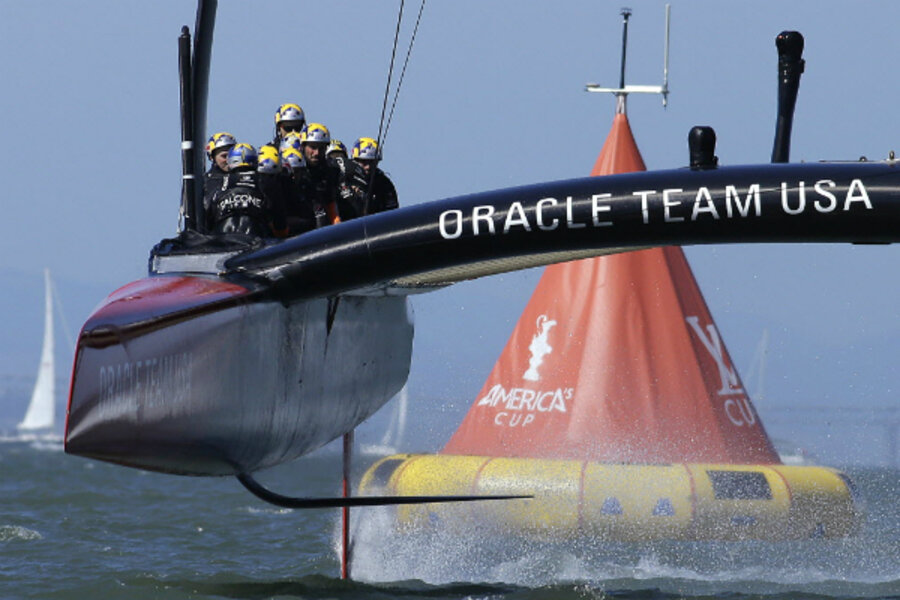America's Cup: How Team Oracle flew past the wind to revive yacht racing
Loading...
| ATLANTA
The amazing winner-take-all showdown between the Americans and the Kiwis in America’s Cup 2013 on Wednesday afternoon has become a Cinderella moment not just for sailors crewing boats that now sail way faster than the wind, but also for a TV audience looking for speed and a hint of danger.
After his win at the last America’s Cup in 2010, Oracle Team USA's owner, tech magnate and adrenaline junkie Larry Ellison, threw down the gauntlet for the next race: Double the hull, quadruple the speed. That gambit by a high-flying American industrialist could catapult sailing into the top echelons of racing sports, but it has arguably already had deadly consequences, causing critics to pan America’s Cup 2013 as a “billionaire death match.” (It now takes an easy $100 million to pose an America’s Cup challenge.)
Mr. Ellison “is obviously financially involved, but that’s not as important to him as the risk that he took in staging this spectacle on San Francisco Bay, in these high-tech catamarans, where nobody thought it was going to take hold, and now it’s taken hold in a bigger way then I think he had dreamed,” says Julian Guthrie, a San Francisco journalist who chronicled Ellison’s America’s Cup journey in “The Billionaire and the Mechanic.”
Designers found new orders of speed to tap by utilizing hydrofoils that in essence allow the 72-foot-long, 13,000-pound AC72 catamaran, powered by a stiff 131-foot wingsail, to lift out of the water and fly, trailing only a sliver of foil in the water. That technological leap forward raised top speeds from around 10 knots to over 40 knots – speeds achieved with the wind blowing 20 knots or less.
“The AC72s will look amazing, will be very fast, and will take the America’s Cup into a new dimension,” Pete Melvin, one of the boat’s designers, said in 2010.
Those predictions have borne fruit. Since the racing started on Sept. 7, excitement has been building as the two boats jockey gunwale to gunwale at breakneck speeds in San Francisco Bay – notable for its heady winds. America's Cup 2013 also marks the first time the race has been held within easy viewing distance from shore. Crashes, rule infractions, and tactician changes intensified the drama as Team Emirates New Zealand took a commanding 8-1 lead in the first-to-9 competition.
But few sailing enthusiasts could have dreamed up what’s become a crazy comeback by the American boat, helmed by Jimmy Spithill (an Aussie). But as the regatta entered its second, then third week, something peculiar happened: The American boat got faster and faster, climbing back race by nail-biting race until the crew won another exciting heat on Tuesday by drawing to an 8-8 tie. That sets up a winner-take-all affair Wednesday. [Editor's post-race note: Oracle Team USA won the race and the Cup]
“We're not going to stop – we're going to keep going all the way to the end," Mr. Spithill declared on Tuesday. "We really want this. You can sense it on board."
It has looked as if Spithill and his Oracle crew found a gear that Kiwi skipper Dale Barker has so far been unable to engage in his own boat.
“We’re witnessing one of the greatest comebacks in the history of sport!” yelled spectator Paul Kaba, according to the San Francisco Chronicle. “Our team has completely mastered the waters of the Bay!”
The comeback has led to the New Zealand press nearly writing Mr. Barker’s boat off, with stories about how the Kiwis, hungry for success and a boost of national pride, have managed to snatch defeat from the jaws of victory. “New Zealand is facing one of the greatest collapses in sporting history,” wrote the Chronicle’s Al Saracevic, heaping it on.
With that kind of international high drama, the spectacle in San Francisco Bay practically ensures a new profile for the sport. In anticipation of the backdrop and the high speeds under the AC72s, NBC agreed to televise the America’s Cup on network primetime for the first time in 20 years, a decision which is now likely to yield a ratings bonanza.
But with that excitement, or as part of it, comes the inherent danger of racing lanky sailing vessels at such high speeds.
Andrew “Bart” Simpson, an English Olympian, died in May aboard the Swedish challenger, Artemis, after the boat somersaulted during a hard blow on the Bay. The Oracle team, too, pole-pitched its first boat only eight days into practice, leaving the massive wingsail to be tugged underneath the Golden Gate Bridge and into the Pacific by a strong tide.
“There’s so much danger involved that you’re always on the edge of your seat,” says Ms. Guthrie. “The popularity has increased with either the perception of danger or the reality of danger … [people watch because] they’re both dreading a crash and anticipating one."
Some say that new attitude is not just dangerous, but “killing a 160-year-old tradition,” as San Francisco sportswriter C.W. Nevius told The Verge online magazine this summer.
Or are they, boldly, creating a new tradition, as San Francisco stands to make as much as $900 million in extra revenue from the race and designers continue to push the limits of sails and speed.
The new America’s Cup manifesto came out in 2010, where it said America’s Cup 2013 would, specifically, “ensure fast, exciting racing” and “capture fans’ imaginations.”
So far, so good, given what Yachting World’s David Glenn on Wednesday called “a comeback story of unbelievable proportions [and] the unexpected success of the most outrageous yachts seen in the history of the sport."






